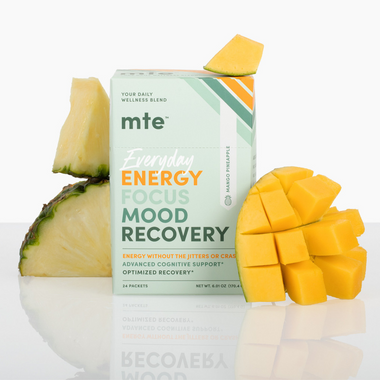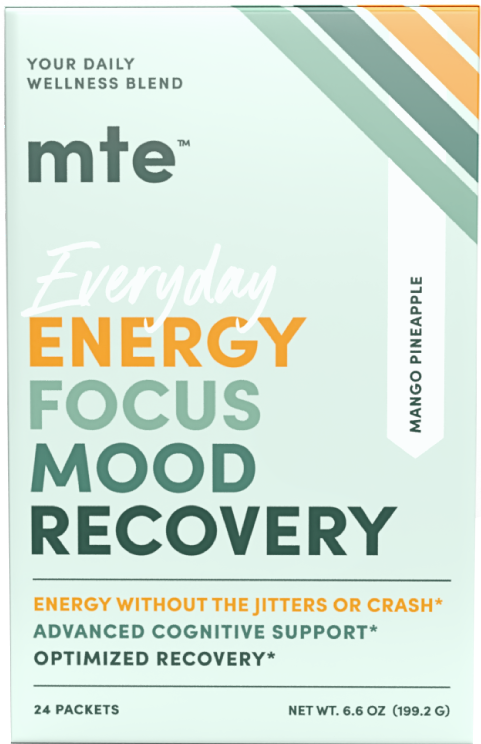
Understanding the Dangers & Mechanisms of Chronic Stress
Everyone gets stressed at least once in a while. Things like big life changes — good or bad — can cause a short period of poor sleep, fatigue, headaches, and overall irritation with daily life. And then there are those instants of acute stress, like when you almost rear end someone and your stomach drops as your heart rate seems to double in the span of a second.
To some extent, these responses are normal — we have a biological stress response for a reason, don’t we? No big deal. But the issue arises when we’re stressed out all the time, which we are. Work, family, friends, school, exercise, cooking, housework, hobbies — there’s a lot packed into each day. Top it off with the 24-hour news cycle, social media, and endless streaming services, and we are overstimulated, overwhelmed, and underslept all the time. No wonder we’re always tired and low-key p*ssed off.
Constantly sitting at that level of anticipating the next thing you need to do is hurting your health in some very real ways. And it doesn’t have to be chronic live-or-die stress to wreak havoc. A main biological mechanism of the stress response is releasing the hormone cortisol (the body's stress signaler) into the bloodstream to give your brain and body that boost you need to get through whatever it is.
But it turns out cortisol isn’t so cute. Too much of this hormone for too long isn’t boosting anything except your desire to curl up in bed, sleep for 4 days, and never talk to anyone again. And it’s also doing a bunch of things that are much worse, like ruining your sleep, causing chronic uneasiness, stressing out your nervous system and heart, and even hurting your brain. Long-term stress = long-term health problems. It’s high-key scary.
Stress Statistics: We Are Not Okay
Before we get into the details of where our ability to (or to not) manage stressful moments comes from and why it’s not exactly helping, let’s take a quick look at some statistics on stress in the US from the latest Harris Poll, done on behalf of the American Psychological Association in 2022:
- 55% of Americans are stressed during the day. That’s 20 points higher than the global average.
- The most stressed out state is Louisiana, at 59.94 points. The least stressed state is Montana, at 26.81 points.
- 57% of survey respondents said stress leaves them feeling paralyzed.
- Almost 2/3 workers in the US say they’re ready to quit their job because of work-related stress… kind of makes that whole corporate “chronic unease is productive” crap seem almost abusive, doesn’t it?
- 94% of Americans have chronic stress at work.
- 35% say their boss is the main source of their stress at work.
- 80% point to poor company communications as a cause of daily stress.
- For sources of chronic stress:
- 39% report work as their main cause.
- 71% of people with private health insurance and 51% of people with public health insurance pointed to cost of healthcare as a big contributor.
- 42% report personal debt as a major source.
- 1 in 4 Americans report discrimination as a significant cause.
- Mass shootings are consistently pointed to as a cause of stress by all ethnicities, but the demographic with the highest rates is Hispanic at 84%.
- 54% of people who want to follow the news to stay informed report that following current events stresses them out.
So, how did we get this way? Why does our body have this specific stress-response architecture if it’s just damaging us from the inside out? And is there any way to hack our stress response back into a functional place? (Hint: yes)
Fight, Flight or Freeze: The Origins of Stress Response in Humans
It’s no secret that life wasn’t exactly safe and sound 120,000+ years ago when we were first walking out of the Great Rift Valley. There were many, many dangers one encountered in the Paleolithic Era, from rough terrain to inclement weather to rampant pathogens, reliance on hunting and foraging, and megafauna roaming the lands and waters.
When an archaic human encountered a source of stress, it was pretty much always about life and death. Think about it: when your mode of life is pure subsistence, stress is going to come from (1) imminent danger from the outside, whether it's people, animals, weather, etc, (2) resource scarcity, and (3) injury/illness. This meant that to stay alive on the short and long term, our bodies needed a biological mechanism that trips and responds instantly when necessary.
A salient illustration of initial human stress structure:
stimulus 🡪 stressor 🡪 stress 🡪 stress response 🡪 effect
For example, say there is a dispute between two migrating bands of archaic humans that escalates to violence.
- Stimulus: Someone pulls out an obsidian knife and yells at you.
- Stressor: An angry person with a knife means to harm you.
- Stress: What is going to happen in the next few seconds as this continues to escalate? (lizard brain weighs the options: fight, flight or freeze)
- Stress response: You pull out your own obsidian knife and yell back. (fight)
- Effect: They retreat. You put your knife away and your heart rate starts to slow again. (stress response: largely over)
At the earliest of human history, the vast majority of stress occurred in isolated and/or specific events: taking down that unreasonably large bear or making sure your band got through the mountain pass before the first snow. And that’s largely how it remained for the majority of human history; until we started choosing more permanent places to live and shifted to living in larger, socially-defined groups between 25000 and 17000 years ago.
Basically, the emergence of civilization, which we can all agree has been pretty cool – cities, monuments, agriculture, technology, medicine – changed the way stress worked in human lives. Hunting and gathering is actually the least stressful mode of living, believe it or not, largely because it’s the mode of life with the least labor costs. Once you’ve got land to tend and goats to herd and several small children to feed and war to worry about, there’s always something to anticipate. Which means there’s always something to stress about. Enter: chronic stress.
Fast forward to today, when chronic stress is endemic to the very structure of our society, and we’re left with an outdated biological mechanism that spends way more of its time hurting us than it does helping. We weren’t ever supposed to live like this, but the reality is that we do, so we need to find ways to boost our resilience to chronic stress.
Why Lagging Biology Leaves Us Tired & Listless
The human stress response is centered in the hypothalamic-pituitary-adrenal axis (HPA axis). Initially, when you encounter a stressor, your sympathetic nervous system senses the situation and immediately releases neurochemicals that boost your energy, focus and heart rate. Shortly after, the HPA axis responds to the stressor:
- The hypothalamus releases CRH, the hormone that regulates the HPA’s role in stress response.
- CRH signals the pituitary gland to continue to boost the sympathetic nervous system.
- The pituitary gland releases ACTH, a regulator of steroid production.
- ACTH signals the adrenal system to create the stress response hormone and release it into the bloodstream.
Once your bloodstream is flooded with the stress hormone we all know too well, it scrapes up all the glucose it can find to give your mind and body a super-boost of energy. Increased levels of pro-stress chemicals also increases blood pressure, which pushes more oxygen through your organs and muscles, and is also thought to play a role in cognitive response – both memory blocking or memory retention of the stressful event.
This is all fine and good when dealing with stressors every now and then, but once we sat our packs down and started building our first seasonal homes, we were dealing with ongoing stressors daily. And a few thousand years later, capitalism made it so we were dealing with long-term stressors all day every day for years or decades or a lifetime. And evolutionary biology just wasn’t built for that nonsense. Which is why we’re all having so much fun.
Modern human stress structure, then, is a little more complicated than the initial illustration. A more appropriate architecture for today:
Stimulus 🡪 stressor 🡪 sustress, eustress or distress 🡪 inadequate, mild or severe stress response 🡪 weak, beneficial or damaging effect
If that sounds messy, let’s take a minute to explain:
- When the stressor fails to challenge your feeling of balance, it leads to an insufficient stress response, which leads to an insufficient effect. This is known as sustress.
- When the stressor mildly challenges but doesn’t disrupt your feeling of balance, it leads to a mild stress response that’s appropriate for the situation, which leads to beneficial effects. This is known as eustress. This is the healthy area we would like our stress resilience to stay at.
- When the stressor severely challenges and disrupts your balance, it leads to an extreme stress response, which leads to damaging effects. This is known as distress.
Unfortunately, most of us are a little closer to the distress end of the spectrum than we’d like to be a lot of the time.
The Distressing Dangers of Chronic Stress Activation
We all know what feeling stressed all the time is like. You’re tired day and night, but you can’t ever seem to get any real rest. You’re irritable and foggy even though you’ve had three cups of coffee. You’re hungry, like, all the time but forget to eat until it’s 8pm. Maybe you get stress breakouts or rashes. Maybe you get the nervous sweats even though you’re literally shivering. And then there are the headaches and your heartbeat pounding in your ears.
All of this is unpleasant, sure, but is it really dangerous? The amount of caffeine you’re drinking probably is! But it’s what’s going on below the surface that’s the scary stuff:
- Constant raised stress levels and increased blood pressure increases risk of cardiac events like stroke and heart attack.
- Constant stress depletes your body’s resources and can lead to exhaustion and problems with mood regulation.
- Chronic activation of the sympathetic nervous system doesn’t allow the parasympathetic nervous system to do its job. Read: biologically, you can never calm down.
- Part of the stress response is muscles tensing up. Constant tensing (think teeth clenching) can lead to chronic pain and seized muscles.
- Unbalanced hormones and an overactivated brain leads to internal miscommunications that can cause digestive issues and even stomach ulcers.
- Chronic high levels of the stress hormone suppresses your immune system, leaving you more susceptible to illness.
Because your brain controls pretty much every single thing that your body does from a straight up cellular level, it follows that all these maladies stem from how chronic stress hurts your central nervous system and its ability to properly do its job. This can lead to psychiatric illnesses, burnout, and can even permanently damage your brain’s ability to emotionally regulate.
But that’s not all chronic stress does to the brain:
Lowered Immune Response
The hormones released during the stress response don’t only get to their targets; they get to other cells as well, including immune cells, which then react by overreacting. Which is fine in isolated incidents, but on a consistent level becomes unhealthy. Chronic immune activation causes chronic low-grade inflammation. Inflammation + an immune system zapped of its resources = fragile health.
Neuronal Atrophy
Animal studies have observed reductions in the prefrontal cortex (critical thinking) and limbic systems (emotional regulation) as a result of chronic stress. This is accompanied by decreased neural plasticity and decreased spine density. These physical alterations are extremely similar to those in the brains of humans with depression, stress and trauma-related syndromes and chronic psychosocial strain.
Poor Heart Health
Stress responses stimulate inflammatory leukocyte production. These leukocytes directly stimulate new cell production throughout your vascular system. On a chronic level, this creates a new neural pathway to handle the chronic and unnecessary infiltration of leukocytes, which damages blood vessels and contributes to plaques, both of which can lead to heart attack and stroke.
Psychological Problems
Part of what happens when your brain's stress-response axis is overactivated is the production of harmful compound that inhibit neural plasticity, neural protein synthesis and spine formation. This leads to synaptic impairment (read: literal brain damage). That’s all unnecessary science vocab to say that long-term stress hampers your brain’s and spinal cord’s communication abilities while it permanently damages their communication skills.
Help Your Health by Managing Stress from the Inside Out
Okay, so let’s bring it back up a bit. Because, while chronic stress is just a reality of daily life in the 21st century, you don’t have to accept it and let stress slowly take you down. There are lifestyle habits you can change and natural remedies you can use to hack your own stress biology to become more resilient and able to adapt to stress. Which means better health and a better life that actually feels fun sometimes.
Exercise Regularly
When it comes to science, there is no question that physical activity supports, protects, and even improves your health. And that includes stress-induced damage on your body and brain.
Studies have shown that exercise not only supports neural plasticity (read: cognition, learning, focus) and neurotransmitter communication (read: mood, sleep), but it also improves the systems that support those systems – neurogenesis, metabolism, and the cardiovascular system.
Eat Well
Another lifestyle factor there’s no question has the ability to affect perceived stress is your diet. It’s a general rule that good foods make you feel good. As a whole, a balanced, nourishing diet provides your body the ingredients it needs to function at its best, which means more energy to handle stress.
There’s clinical evidence to indicate that omega-3 fatty acids and vegetables play a role in regulating cortisol levels and reducing inflammation. And fiber has been associated with decreased levels of perceived stress. Plus, a nutritious diet counteracts oxidative stress on the body and helps repair cell damage.
Oh, and cut down on the caffeine – it’s ruining your sleep and making you feel moody and reactive to the smallest inconveniences.
Slow Down
You’re not a machine! Well, you’re not just a machine – you need to take care of yourself in a mindful way, too. If doom scrolling stresses you out, take a break from it. If you find yourself feeling burnt out at work, take a sick day. Just generally feeling overwhelmed? Take a few minutes – or way more than that – in a quiet, comfortable space where you can relax.
Doing what your body tells you it needs is just as important as giving your body the things it needs to thrive. It’s a two-way street. Be compassionate with yourself. #itscalledselfcaresweetie
Give Your Stress-Busting Routine a Plant-Powered Boost
Along with living a healthy lifestyle, we love using adaptogenic herb blends to support these buffered stress responses. Adaptogens are plants and other flora believed to have bioactive properties that help the body cope with stress. Just like long-term stress can mess you up, long-term adaptogen use supports getting your body back into balance and shore up its defenses. Three of our favorite adaptogens for stress are:
Ashwagandha
It would be insane to talk about adaptogens that may help manage stress without talking about ashwagandha. 6000+ years of experiential evidence indicates this powerful herb useful for a ton of maladies, and stress is just one of those.
Bioactive compounds in ashwagandha appear to help regulate levels of the stress hormone and its harmful protein byproducts of a prolonged stress response. This adaptogen may also lower the overall activity of the CNS, resulting in a non-drowsy calming effect that combats stress and sensitivity to stimuli.
Eleuthero
This adaptogen, also known as Siberian ginseng, also has several thousand years of use in traditional medicines to back its bioactivity claims, especially when it comes to mental and physical stress. And today, clinical research is starting to back that use-based evidence up with hard data.
In laboratory settings, eleuthero has been observed to reduce stress-induced damage to the thymus and spleen, improve sleep duration and quality, promote T-cell and immune cell activation, and improve mental and physical performance under stressful conditions. In tandem, it’s also been seen to reduce blood pressure and cholesterol, as well as improve perceived quality of life.
You can find these adaptogens, a couple more, a bunch of powerful nootropics, and even a couple superfoods in a single scoop of MTE. Which makes for a pretty convenient, quick healthy habit to add to the list above. And with all the nasty tolls chronic stress takes on your body, a natural stress-relief drink certainly couldn’t hurt!
An energy greens supplement replacing excessive caffeine with 10 natural bioactive ingredients, MTE offers support for stress, mood, recovery, immunity, energy, focus, and inflammation; you know – literally all the major things chronic stress can mess up. Take control back from the wear and tear of the daily grind; get back to living your best life and feeling great – the way we were always meant to feel.






